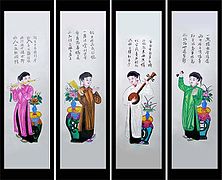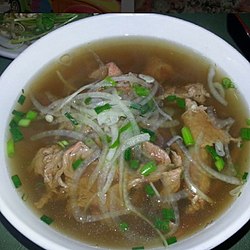
Back Gastronomía de Vietnam AST Vyetnam mətbəxi Azerbaijani Lutong Vietnamese BCL В’етнамская кухня Byelorussian Виетнамска кухня Bulgarian ভিয়েতনামী রন্ধনশৈলী Bengali/Bangla Gastronomia del Vietnam Catalan Vietnamská kuchyně Czech Det vietnamesiske køkken Danish Vietnamesische Küche German
| Part of a series on the |
| Culture of Vietnam |
|---|
 |
| History |
| People |
| Languages |
| Cuisine |
| Festivals |
| Music |
| Sport |
This article needs additional citations for verification. (January 2013) |



Vietnamese cuisine encompasses the foods and beverages originated from Vietnam. Meals feature a combination of five fundamental tastes (ngũ vị): sweet, salty, bitter, sour, and spicy. The distinctive nature of each dish reflects one or more elements (such as nutrients and colors), which are also based around a five-pronged philosophy. Vietnamese recipes use ingredients like lemongrass, ginger, mint, Vietnamese mint, long coriander, Saigon cinnamon, bird's eye chili, lime, and Thai basil leaves.[1] Traditional Vietnamese cooking has often been characterised as using fresh ingredients, not using much dairy or oil, having interesting textures, and making use of herbs and vegetables. The cuisine is also low in sugar and is almost always naturally gluten-free, as many of the dishes are rice-based instead of wheat-based, made with rice noodles, papers and flour.[2] Vietnamese cuisine is strongly influenced not only by the cuisines of neighboring China, Cambodia and Laos, but also by French cuisine due to French colonial rule over the region from 1887 to 1954.[citation needed]
Kikkoman, a leading soy sauce manufacturer, did market research confirming that fish sauce (nước mắm) is the predominant table sauce in Vietnamese homes, where it captures over 70% of the market, while the share for soy sauce is under 20%.[3]
- ^ "Vietnamese Ingredients". WokMe. 2011. Retrieved 2 December 2011.
- ^ "Healthy Eating: Seven Reasons Why You Should Start Eating Vietnamese Food". HuffPost. 23 April 2014.
- ^ Fututame, Nami. "Soy Sauces of Asia [ Soy Sauce Usage in the Philippines, Thailand, and Vietnam ]" (PDF). Kikkoman Cop.
© MMXXIII Rich X Search. We shall prevail. All rights reserved. Rich X Search